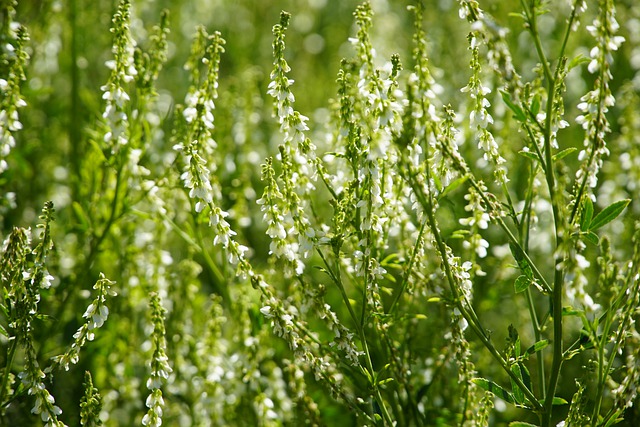 |  |  |   |  |
 |
In the second year of life, the white melilot begins to form an upright and branched stem, up to 60-170 cm in height. The plant is biennial. The pages are composed of three leaflets.
Flowers 20-50, which grow in leaf axils, arranged in bunches
Flowers are small, 15-40, in long bunches in leaf axils. The plant blooms from June to September. One plant blooms on average for a month, each flower lives for 2 days.
Fruit an egg-shaped pod with a corocot surface. Ripe in July-October.
For medicinal purposes, the above-ground part of the plant is collected, usually the tops with inflorescences and leaves. Harvesting is done during flowering.
White melilot is collected in dry and clear weather, in the morning. Dry in a shaded and well-ventilated area, such as an attic. It is also allowed to dry in special dryers, not exceeding a temperature of 40C. For natural drying, the plant is spread in a thin layer (<5cm) on the growth or paper, periodically in bulk bags. The finished drug has a pleasant aroma and a peculiar, bitter taste. Store in a hermetically sealed container for no longer than 2 years.
The surface part of the plant contains choline, coumarin (0.35-1.6%), molotic acid, melilotic acid and o-coumaric acid, tannins, essential oil, vitamin C, resins; the seeds also contain vegetable fats, proteins and small amounts of starch. In the last phase of the plant's flowering, the vitamin E content also increases.
Medicinal significance
Preparations made from white or medicinal mistletoe are endowed with wound-healing, pain-relieving, expectorant, carminative, sedative, hypotensive, antiseptic, diaphoretic properties. Interestingly, white melilot has a stimulating biogenic effect, which is several times stronger than that observed in aloe vera.
Coumarin depresses the CNS producing anticonvulsant effects. In addition, the means of this plant contribute to the increase in the amount of leukocytes in the blood, in the case of leukopenia caused by radiation sickness. However, it is important to know that this plant can only be used under the supervision of a specialist.
Water extracts of the plant are used as antibacterial and insecticidal agents.
White melilot is also used with good results for the treatment of dental abscesses, rheumatism, mastitis, otitis media, thrombosis, myocardial infarction. It helps to get rid of cold sores, slow-forming boils, embolism and thrombophlebitis.

